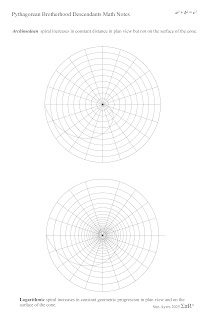φ6R Extreme and Mean Isosceles Triangle Spiral
This spiral study, suggested by my friend Alexis, was meant to be a sandbox of ideas on different types of spirals. Here are the results of this sandbox study on spirals using Euclid's Extreme and Mean Ratio, the Golden Ratio, Bach's music theory on the 6th root, and drawings by Rafael Araujo.
Alexis Doval's drawing of the Isosceles triangles cut into extreme and mean ratios of the Golden Ratio.
If the lines AF and CF were a single straight line, they could be cut into extremes and mean and equal to the Golden Ratio.
If the lines CF and BF were a single straight line, they could be cut into extremes and mean and equal to the Golden Ratio.
After the Isosceles triangles are developed and cut into the Extreme and Mean ratios, the radius of the cone is taken and used to calculate the length of each construction ray in plan view by the 6th root.
Then, you bring the lengths of the construction rays that define the spiral up to the profile view. Where these lengths intersect, the cone slant line will determine the arcs for the cone surface. Then, use the intersection of the arcs and construction rays on the cone surface to develop the spiral on the cone surface.
The sixth root of a number is the number that would have to be multiplied by itself 6 times to get the original number.
Golden Ratio Spiral based on Rafael Araujo drawing.
The vertex of each isosceles triangle is the center point of each arc.
Note: φ6R Extreme and Mean Isosceles Triangle Spiral is Logarithmic
The Golden Ration Spiral is not a Logarithmic or an Archimedean Spiral.
Archimedean spiral increases in constant distance in plan view but not on the cone's surface.
Logarithmic spiral increases in constant geometric progression in plan view and on the cone's surface.
Fibonacci Icosahedron based on the drawing from Rafael Araujo
Note: The Fibonacci Spiral has nothing to do with the Icosahedron; it just looks neat.












No comments:
Post a Comment
Note: Only a member of this blog may post a comment.